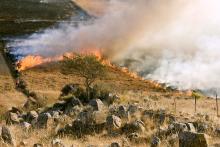
Fast, affordable Internet access for all.

UTOPIA Fiber, the publicly owned, open access network, has begun a pilot wildfire-detection project which has the potential to provide safer, faster, less expensive service to communities in Utah, saving the state tens of millions of dollars a year in firefighting and other economic costs. The EDWIN Project (Early Detection Wildfire Imaging Network), currently in beta testing, pairs advanced thermal imaging cameras with the fiber network’s infrastructure to help firefighters in the region detect events in real time. The pilot project — currently deployed to Woodland Hills (pop. 1,600), Murray (49,000), and Layton (77,000) — just launched, with plans to expand.
Standing Watch
The project’s focus right now is the Wasatch Front metropolitan area, where more than two million residents live. That’s 80% of the state’s population, and because the region is arid and hot in the summer it’s particularly vulnerable to wildfires.
The setup is simple: thermal cameras are placed at key geographic points in the region and connected to UTOPIA’s fiber network. The cameras, which look to be FLIR’s PT-series, scan the region continually and are used to provide real-time image processing at resolutions of up to 640x480 pixels. Should a reading hit 300 degrees Fahrenheit, a notification is sent to first responders, who can log into the camera’s perspective and confirm the presence of an out-of-control fire. They can then dispatch the appropriate units to the area.
“The EDWIN Project thermal imaging cameras are so advanced, they can detect a hot spot down to a pixel,” explained Roger Timmerman, executive director, UTOPIA Fiber.
Woodland Hills was the first to join; the community was devastated by wildfire damage in 2018. Firefighting typically relies on community members to call in and report an event, a system with a lot of obvious points of friction that can dramatically slow evaluation and response times. UTOPIA’s network allows instant notification and real-time video, which will reduce the latter. It will save participating communities, the state, and the federal government tens of thousands of dollars per minute in direct and indirect costs by providing crucial early detection.
A Costly Problem
The EDWIN Project was developed by the UTOPIA Smart Cities team in conjunction with Brigham Young University.

While wildfires play an unmistakable ecological role in revitalization of the landscape, they take a heavy economic toll on surrounding communities. On average, more than 70,000 wildfires burn almost 7 million acres across the United States each year [pdf], costing tens of billions of dollars of damage. Fires in the Western part of the United States tend to be larger, and Utah in particular gets hit by an average of 1300 every year, for a loss of 250 thousand acres. So while each of the cameras runs $20,000, in the end the region will save significant money. Wildfires also have a disproportionate effect on communities of color. The three current pilot cities are overwhelmingly white, and hopes are that UTOPIA can work to extend the the EDWIN Project to more diverse communities.
Firefighting has gone high tech in the last decade and a half, including everything from automatic detection via satellites, wearable technology for firefighters to get a better picture of what’s going on on the ground, and the use of drones and other aerial vehicles to evaluate and inform responses. In each of these cases, however, frontline detection and information gathering relies on robust networks to transmit large amounts of data in real-time. For the EDWIN Project, the fact that the cameras are always on and directly connected to UTOPIA’s network is a big plus.
“None of this would be possible without fiber connectivity,” said UTOPIA Executive Director Roger Timmerman at the announcement. “There’s an enormous amount of data that has to move seamlessly and instantly. The EDWIN Project shows that fiber connectivity can power technology to address community needs. If all goes well, EDWIN will be a game-changer—and literally a life saver—for the residents and businesses of Utah and beyond.”
Watch the live stream anytime.
UTOPIA Fiber was begun in 2004 by 11 member cities, and currently operates an open access network with 12 ISPs subscribers can choose from. It’s experienced significant growth recently; in March the network completed its Layton buildout for a cost of $23 million, and just this week announced it would be connecting Clearfield to the network. Listen to episode 331 of the Community Broadband Bits podcast to hear more about the UTOPIA network.
Image by Steve Buissinne from Pixabay

The U.S. Treasury Department announced another six states have been approved to receive nearly $1 billion in Capital Projects Funds from the American Rescue Plan to bring new broadband infrastructure to more than 180,000 homes and businesses.
Lehi City, Utah has broken ground on its new citywide fiber optic broadband network. The network, which city leaders say should take somewhere around three years to complete, will be built on the back of Lehi’s Utilities Department, part of a growing trend of U.S. utilities using an historic infusion of federal funding to expand affordable broadband connectivity. The Lehi Fiber Network will operate as an open access network, meaning that multiple ISPs will be able to utilize the city’s new infrastructure, providing a much-needed dose of broadband competition to local residents and businesses alike. Five ISPs have already committed to providing service over the city-owned fiber.
